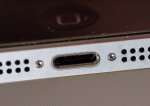
Apple’s new iPhone 5 comes with a completely new connector, a first since the introduction of the 30-pin model alongside the 3rd generation iPod (though that version received updates including video capabilities along the way). The new Lightning connector is 80% smaller than the 30-pin version, and it has a much better name than “30-pin dock connector.” But in many other regards, it’s a bit of a mixed bag for consumers. And yet, after a few days of frequent use, I love it. Here’s why.
First, actually, let’s talk about what’s not so great about Lightning. There’s the proprietary nature of the connector, which mostly means that it’s not based on a universally adopted standard like Micro-USB. Micro-USB, many argue, would make things much easier; the cables are already everywhere, since accessory makers and other smartphone vendors use them frequently in their products. Replacements, both at home and in stores, would then be incredibly easy to drum up.
Another problem with Apple’s version of proprietary in the case of Lightning is that there are indications this version is much more locked down than previous versions, thanks to the inclusion of a so-called “authentication chip” identified by Double Helix Cables (via AppleInsider). According to Kyle Wiens of iFixit, who I spoke with earlier today, that means users should wait and get cables only from Apple itself or from properly licensed manufacturing partners – those knock-offs on eBay or elsewhere on the web are definitely a risk.
It doesn’t help that Apple’s own cables are in short supply (2-3 week lead time on Apple’s site), and expected to stay that way for a while at least due to the complicated manufacturing process involved in their creation. That’s causing some problems for iPhone 5 owners already, and is bound to lead to power deficiency issues. I’ve already ordered a couple of backups, but it could be a month before I see them. In the meantime, look for tweets from me similar to this one:
I foresee a lto of this. RT @film_girl: I left my one Lightening cable at home and have no way to charge my iPhone 5. Sad panda is sad!
—Ross Rubin (@rossrubin) September 25, 2012
Wiens says that users can expect Apple and third-party vendors to catch up, though he believes the Lightning connector isn’t built for dock integration in the same way as the aptly-named dock connector was, and in fact that’s likely why Apple didn’t release a dock of its own. Manufacturers aren’t likely to release the kind of one-size-fits-all docking products users have enjoyed up until now; instead, generation-specific devices aimed at the iPhone 5 and the iPhone 5 alone become much more likely.
Despite the problems listed above, the Lightning connector is a great addition to Apple’s mobile devices. Mostly that’s because it can be inserted whatever way one wants, a trick achieved (as AppleInsider explained in detail this morning) via dynamic assignment of pin function. After years of using cables that are very specific about which way they’re plugged in, spending the past four days using one that couldn’t care less has been nothing short of amazing.
You might think I’m exaggerating, but think about it this way: take the most menial, mind-numbing repetitive task you do during the day, something that’s simple enough to accomplish on a one-time basis but that has to be done about 25 times, and just get rid of it. Forget it altogether. Doesn’t that feel better? Now multiply that feeling, since it’s making its way to iPods next, and will inevitably come to the iPad, too.
iPhone 5 users should brace for a change, if they haven’t already. Getting over a technology we’ve been dependent on for nearly 10 years as Apple users won’t be easy (and could be costly in environmental terms), but Lightning actually takes a fundamental, basic part of using and living with a mobile device and improves on it, something that can’t be said for Micro-USB or any other combined data/power connection standard, and that’s worth some temporary discomfort.

